Stories
Sports Togs
1940s
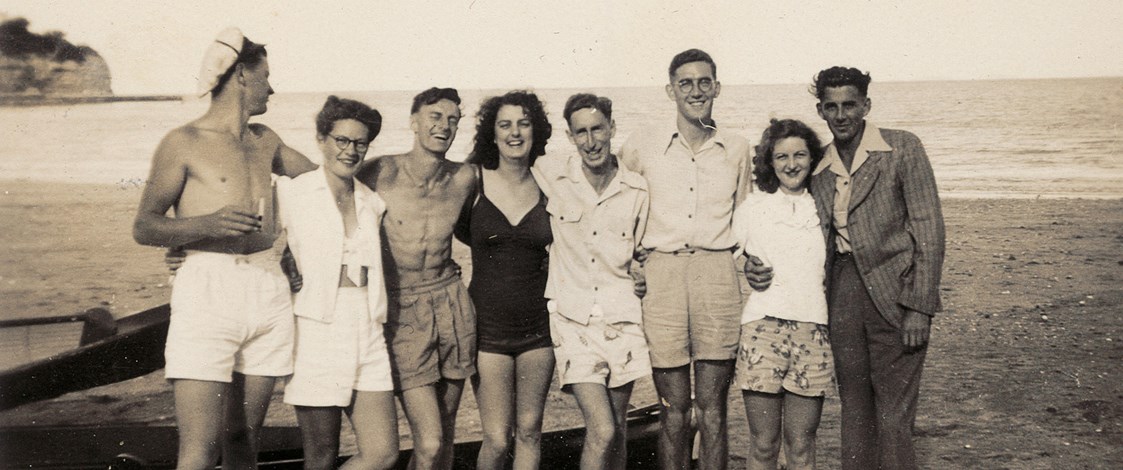
The word togs comes from the Latin 'toga', which in turn derives from 'tegere' meaning to cover and in British slang was applied to a set of clothes, garments intended for a specific use such as 'riding togs' or one would 'tog up' for dinner or tennis.
In New Zealand togs applies to a garment that provides the least amount of cover, the swimsuit. This transition from the general meaning to the specific was made in the 1940s.
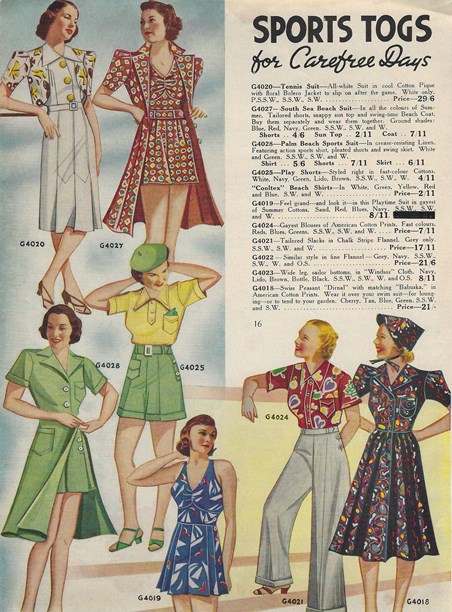
Ad for 'sports togs' in a Farmers catalogue, 1938. Image © Farmers.
Wartime restrictions and austerity measures set up challenges that were often met in creative and liberating ways. What we wore in the 1940s illustrates some of that inventiveness and freedom and is nowhere more visible than at the beach. Away from ordinary workday propriety, our sandy shorelines are at the margins between land and sea where the usual rules do not apply. Here men and women were permitted to recreate and socialise with each other wearing only the scant clothes appropriate for swimming and other physical activity.
The design of women's garments for activities such as cycling, swimming, tennis and golf, had been advanced by French couturiers like Coco Chanel and Jean Patou who designed for the European elite at the resorts in the south of France. Sports togs, as they became known, was a fashion category that appeared in glamorous women’s magazines including our own The Ladies’ Mirror: the Fashionable Ladies’ Journal of New Zealand, which in March 1923 featured a beach scene with a wide variety of casual attire on the cover. Inside, an article 'In Praise of the Sports Girl' was written to counter those who would "denounce the freedom and ardour of the new woman" and who declare "that jazz dancing and mixed bathing are twin pathways to perdition". Instead the author praised the virtues of physical activity in "restoring heart and life", especially for those who indulge in the daily grind behind typewriters and shop counters or working in the mills and factories.
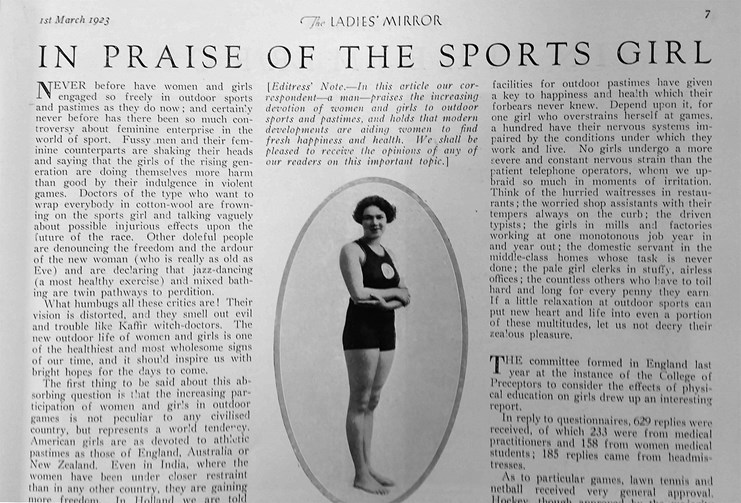
'In Praise of the Sports Girl' from The Ladies’ Mirror: the Fashionable Ladies’ Journal of New Zealand, March 1923.
By the 1940s that particular battle had been won and the seaside as a place of recreation was firmly established with a visit to the beach popular with families and also with young unattached men and women. Pat Johnstone was one of these young women. She lived on Kohimarama Road in Auckland, just by the bay and she grew up in love with boats. Together with her friends, the two Audreys, she sailed a 12-foot Z-class yacht, a Zeddy. Attractive young women, fit, active and healthy, they felt liberated by the sea. Pat also went to the beach with 'the gang' from her work at Woollams Pharmacy Ltd. This group of single men and women would spend a day together at Brown's Bay where they swam, lazed about and danced on the soft sand to music coming from their battery-operated radio. Their beach clothes exemplified the contrast between their working life and their weekend. Monday to Friday they would have their arms and legs fully covered and address each other as Miss or Mr but on Saturday all that was discarded at the beach with the women in bare legs and shorts and the men bare-chested or in open and untucked shirts.
Pat Johnstone and 'the gang' at Brown's Bay. Images © Pat Johnstone.
As a consequence of wartime constraints, sports togs underwent a number of transformations but they also benefitted from and incorporated some of the new materials and technology of the period.
Wool had been required for the war effort and its use in civilian garment manufacturing was restricted, so it was largely replaced by cotton. In swimsuits, this was an inferior option as cotton is cold when wet and slow to dry. As a consequence the wearer wanted to get out of their wet swimsuit as soon as possible and changed into a dry outfit; shorts and bolero combinations, culottes, wraparound skirts, bra sun-tops, and the fashionable new one-piece 'play-suits', a name newly coined by the Paris-based Italian designer Schiaparelli.
The playsuit emerged in the 1940s, worn by women to play sports or lounge by the pool.
Elastic was also in short supply so garments were made more fitted and closed with buttons and zips. Designed by Margit Fellegi for Cole of California, the so-called 'swoon suit' was a two-piece full brief and bra that used ruching and lacing to adjust the fit. Pat Johnstone was the proud owner and model of an orange pinky version that her father had brought from the United States.
Pat Johnstone wearing her Swoon Suit at Kohimarama Beach. Cole of California Swoon Suit, 1942 Acetate satin on display at the California Design exhibition at Auckland Art Gallery, July 2013.
The emergence of the two-piece swimsuit itself was the novel and inventive outcome of wartime restrictions that regulated the permissible amounts of fabric that could be used to make an item of clothing with all garments required to use less. Hitherto prevailing notions of modesty were sacrificed in order to save a modicum of fabric that was removed from the swimsuit between the navel and the bust. Louis Reard took fabric minimisation to the extreme with his bikini, launched in 1946. With briefs that consisted of two inverted triangles joined by string he had to hire a nude dancer to have it shown as no Parisian model would even agree to model it.
In New Zealand however, it was Hollywood and California that inspired how we wanted to look. People not only went to the movies they also kept up with the latest movie news through popular movie magazines like Screen Parade and Picture Show, where all the gossip and the low down on Hollywood style could be gleaned. It was unacceptable for women to be seen in their underwear in the movies but swimwear with sex appeal provided an acceptable alternative and storylines worked hard to create opportunities to show their stars in scant suits. In the early 1940s, Dorothy Lamour became known as the Sarong Queen, with that garment her wardrobe staple in a succession of movies including The Jungle Princess and Road to Singapore and the sarong wrap style became an essential component of the beach glamour wardrobe.

Dorothy Lamour in The Jungle Princess, 1936.
With import restrictions in place in New Zealand since 1938, local manufacturers developed and marketed their own successful brands such as the Pacific Swimwear by Canterbury brand while the demand for popular international fashion brands was met by local companies manufacturing under license. A licensing agreement offered many advantages; it provided local employment, gave access to new fabrics and technology, saved on transport costs and the licensee had a high fashion product with proven market credentials. For fashionable Kiwis it was a win too; it meant that they could look as up to date as anyone, anywhere in the world.

The words in this Canterbury Pacific advertisement are as colourful as the swimwear. We are told that the suits 'fit and cling like nicknames' and that the man’s swim trunks are 'brevities of brilliance'. The women’s swimsuits are made of satin lastex and water- weave wool. Ad from The Ladies' Mirror, December 1939.
Glamour label Mabs of Hollywood was one of the first licenses to be bought by Lane Walker Rudkin in 1947. They also acquired Catalina, the label associated with the Miss USA and Miss Universe pageants, and Speedo. Holeproof Industries, which opened in Auckland in 1938 and made every manner of hosiery, lingerie, knitted and woven outerwear, bought the license to produce the sophisticated Rose Marie Reid label. Cole of California, one of the most glamorous Hollywood labels, worn by Esther Williams in her films, was made in Auckland by California Fashions Ltd while Jantzen, with its sporty profile and a philosophy of flattering the female form, was produced by A J Coleman in Tawa.
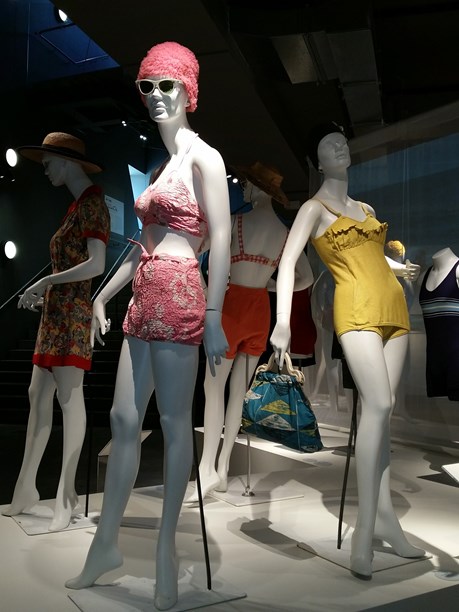
1940s swimsuits by Mabs of Hollywood (left) and Jantzen (right) on display in the At the Beach exhibition.
What we wore to the beach changed rapidly after World War II with the commercial introduction of new man-made materials like rayon and acetate that were developed during the war. Dunlop chemists had transformed latex rubber into reliable elastic thread which was wrapped with other materials like cotton and the new synthetics, to create Lastex and Nylastic which could be used to create swimsuits that were form-fitted while still allowing movement. As the Jantzen swimsuit ad at the time said: 'Elastic, stretch, ease of wear and ease of care are all hallmarks of the materials in this new era.' Ease and functionality were important drivers for swimwear and the fast-growing sportswear category; clothing for informal sport and relaxation away from the dress code of the workplace.

American label Jantzen - with its a sporty profile and a philosophy of flattering the female form - was made in New Zealand under licence.
The development of new labour-saving appliances gave people the luxury of leisure time while the Annual Holidays Act of 1944 guaranteed every kiwi employee two weeks’ paid holiday each year.
Even though World War II had impacted negatively on civilian lives restricting the availability of materials and requiring women to take on men’s work, it had also brought new freedoms in fashion and lifestyle for women. It became acceptable for women to wear trousers and shorts and to be strong and physically active. The need to reduce the size and number of clothing items one had in the wardrobe gave rise to the idea of separates, a more casual approach with garments that could be mixed and matched and layered.
While Christian Dior's New Look had many enthralled and aspiring to Parisian sophistication, in Invercargill H & J Smith department store offered New Zealand women an alternative dress style, the 'American Look'. In December 1947, the store hosted an exhibition of American leisurewear by designers such as Claire McCardell who championed modernity, designing clothing for the active woman.
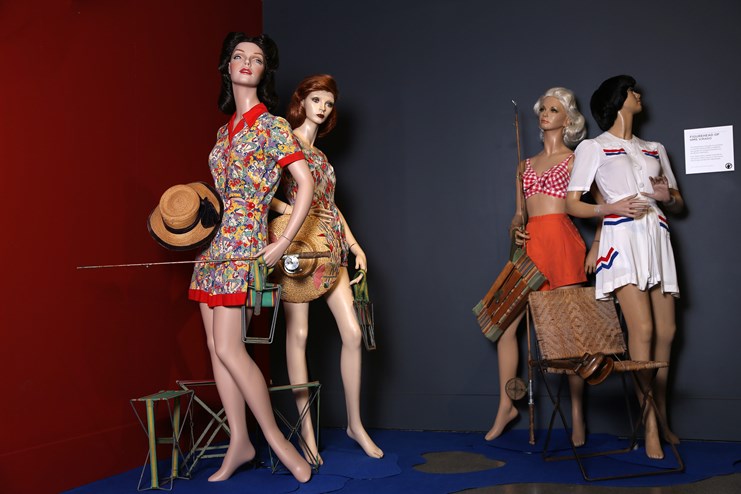
1940s sportswear and separates in the At the Beach exhibition. Photo by Focal Point Photos.
Sportswear and separates can be seen as America's most important contribution to fashion. The sportswear category also delineated the separation of sports togs from real 'togs', the New Zealand swimsuit. It started out as a fashion industry descriptor of informal and interchangeable separates such as blouses, shirts, skirts, and shorts but it came to signify simply a relaxed approach to dressing.
Associated with ready-to-wear manufacturers, rather than haute couture houses, the clothes were intended to be affordable, washable and easy to care for, to have accessible practical fastenings so that you could dress without the help of a maid and with design features that left the wearer the physical freedom to be active. It is not surprising that many of the first sportswear designers were women such as Coco Chanel, Claire McCardell and our own Trilby and Julia Yates.
Text by Doris de Pont. Banner image © Pat Johnstone.
Published January 2020.